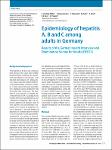Epidemiology of hepatitis A, B and C among adults in Germany
Results of the German Health Interview and Examination Survey for Adults (DEGS1)
Poethko-Müller, Christina
Zimmermann, Ruth
Hamouda, Osamah
Faber, Mirko
Stark, Klaus
Ross, R. Stefan
Thamm, Michael
Ten years after seroepidemiological data were obtained in the German National Health Interview and Examination Survey 1998 (GNHIES98), German Health Interview and Examination Survey (DEGS1) data contribute to a population-based, representative surveillance of hepatitis A and B immunity and of the serological markers for hepatitis C in Germany. The prevalence of antibodies against the hepatitis A virus is 48.6%. In comparison to the situation 10 years ago, seroprevalence is significantly higher among 18- to 39-year-old adults and is significantly lower in those aged 50–79 years. The association between age and seroprevalence has changed, indicating a decrease in naturally acquired hepatitis A immunity. Individual and population immunity has to be achieved through vaccination. Prevalence of hepatitis B antibodies indicates that 5.1% of adults have been exposed to the virus, significantly fewer than 10 years ago (7.9%). Prevalence of hepatitis B surface antibodies indicates that 22.9% of adults have been vaccinated against hepatitis B. Vaccination coverage has increased in all age groups and is highest in the younger age groups. These positive trends can be attributed to the general recommendation since 1995 to vaccinate against hepatitis B. For hepatitis C, the prevalence of antibodies in the general population is 0.3%. Germany thus remains a low-HCV-endemic country.
No license information

